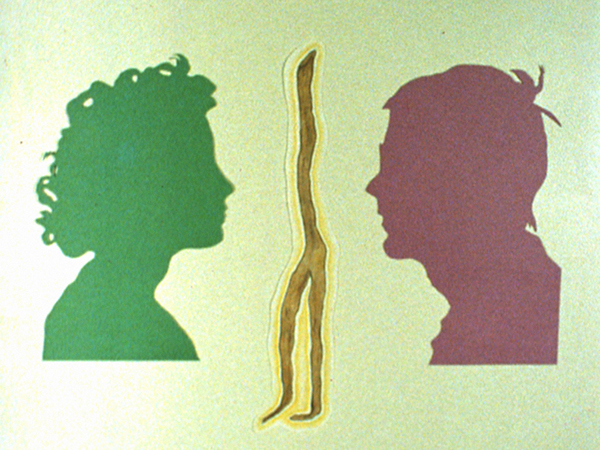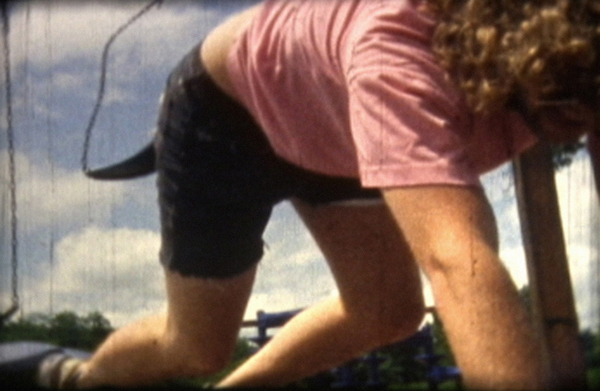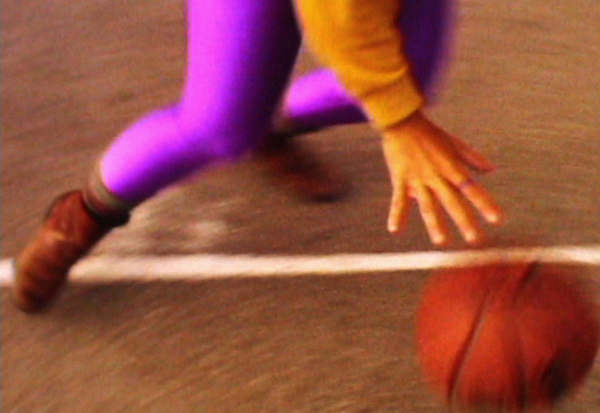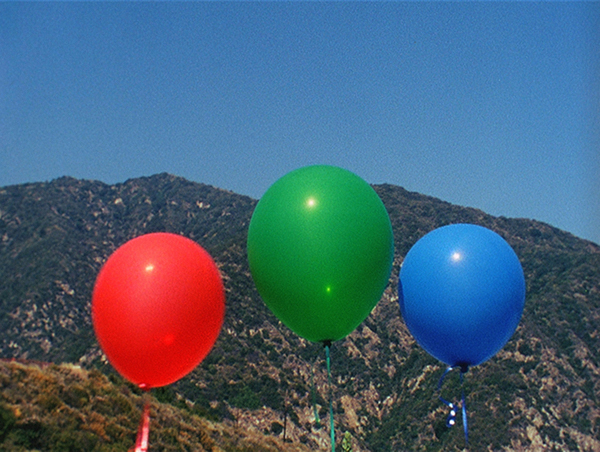How to Keep Your Eyes
Wide Open All the Time:
An
Interview with Alee Peoples
By Clint Enns
 Them Oracles / Alee Peoples
Them Oracles / Alee Peoples
Alee Peoples is an artist from Oklahoma City who currently lives in Los Angeles. Her work uses a playful, DIY methodology to address the personal and the political. Captivated by esoteric forms of communication, Peoples transforms everyday moments and objects into the ecstatic using movie magic. Peoples has previously called Kansas City, Chicago, Philadelphia, and Providence home; however, her more recent work, in particular Them Oracles (2012), Waxing and Milking (2014), Non-Stop Beautiful Ladies (2015) and If You Can’t See My Mirrors, I Can’t See You (2016), celebrate and critique cultural clichés often associated with Los Angeles. Her films are crowd pleasers, demonstrating that it is possible for experimental cinema to entertain without compromising artistic integrity.
A recent solo screening at the Winnipeg Underground Film Festival (WUFF), titled Eyes Wide Open: 5 X Alee Peoples, prompted us to revive this interview after a series of false starts. The interview was conducted via e-mail and collaboratively edited into its current form.
* * *
Clint Enns: How did you begin making films?
Alee Peoples: My friend Che Chen, a really great artist and musician, was shooting Super 8 when we met at a residency. He got me excited about filmmaking and I immediately sent for my dad’s camera which I knew was hiding in the back of a closet. When I returned to Chicago, I became enamoured with the silk banners hanging on the walls of a bar named Skylark. The banners had hand embroidered symbols: open books, bow and arrows, a hand with a heart, skull and cross bones, those types of things. These banners synthesized my interest in image-based language and the symbolic. I did some research and found out that they were made by the International Order of Odd Fellows, a fraternal order akin to the Masons. I thought this would make for the perfect research project. I headed to the nearest Odd Fellows lodge, in Mineral Point, Michigan, with my father's Super 8 camera in hand. This project became my first film, Odd Fellows (2006).
Enns: What attracted you to the Super 8 medium?
Peoples: I was drawn to the camera, the editing equipment, and the Super 8 cartridge itself. They were like forgotten toys. I had been making mix tapes for a long time, so I was familiar with linear editing; hence, physically editing shots together made complete sense to me. I had been into photography since high school, so I already understood the underlying mechanics which helped a lot. As a fan of mail and mail-order music from smaller labels, I enjoyed sending the cartridge to Dwayne's Photo in Parsons, Kansas, and getting a surprise in the mail a week later.
I was excited about all the “tricks” you could perform with the camera including shooting single frames and physically manipulating the film itself. Also, when I was younger, I always wanted to play music but I was too intimidated. Building soundtracks with audio and music allowed me to somewhat fulfill this desire.
 If You Can't See My Mirrors, I Can't See You / Alee Peoples
If You Can't See My Mirrors, I Can't See You / Alee Peoples
Enns: Part of the humor in your work derives from the absurd transformation of everyday objects through simple cinematic “tricks.” For instance, the connection between a ball hitting a wall and a record skipping, or the ways in which airplanes appear and disappear from nowhere in If You Can’t See My Mirrors, I Can’t See You; or when a band supposedly playing in sync with the soundtrack walks away from their instruments in Spotlight on a Brick Wall (2016);or the ways in which seemly mundane (a group of multi-colored balloons, steam leaking from group of rocks, etc.) transform into modern day oracles ready to answer all of our political and personal questions in Them Oracles. Can you talk about your use of humor? Do you see it as a political strategy? Has the avant-garde become too serious?
Peoples: The world is too serious! Perhaps for good reason. There is plenty going on in the world to be upset or bummed out about. Most of the humor comes while writing the treatment and narration. It arises out of an attempt to balance sincere feelings with a lighter tone. I try not to take myself too seriously and I respond well to dry humor and self-deprecation. Comedy is a great way to talk about serious or irreverent issues. It allows us to feel human again. One of humor's greatest strengths can be considered a political strategy: it brings people together through the sharing of a laugh.
I often notice the way an object moves, or some bizarre roadside landscape or advertising that is seemingly ignored or overshadowed by the daily bustle around it. I don't necessarily think that these situations or objects are funny on their own, but through editing I can play with their mood and tone through matching them with sounds and creating rhythm. There are filmmaking tropes I like to play with to remind viewers that they are part of a mediated experience. For example, by switching from first person to direct address, by picking up a locked-down camera in the middle of a shot, or by breaking from sync sound. I try to disrupt audience expectations. In time-based media, I appreciate U-turns and actions that deviate from preconceived notions.
News flash: The film I’m currently working on (tentatively titled Decoy) doesn’t have any humor in it. Look for it this fall!
 Crowning Glory / Alee Peoples
Crowning Glory / Alee Peoples
Enns: One of your earliest films, Crowning Glory (2008), is an attempt to re-examine aspects of American history. For instance, through the use of juxtaposition, the film connects the punk rock mohawk hairstyle to its Indigenous roots, undercutting it as a subversive form of self-expression by re-positioning it as a form of colonial appropriation. The soundtrack collages together different songs, including songs that share a title, like Gloria by Laura Branigan and G-L-O-R-I-A by Them. Can you talk about the soundtrack and its connection to the work?
Peoples: Crowning Glory came from an obsession with the Statue of Liberty’s headdress. What is going on there, really? From there, I looked at all sorts of “headdresses” and adornments. This search coincided with my love for historic, political symbols and icons and how they are embedded in everyday objects, like money and architecture. This is also what attracted me to the Odd Fellows banners.
“Glory” is a noun that is intimately connected with American patriotism. For instance, “Old Glory” is a nickname for the American flag. In the Laura Branigan sample, we never hear the chorus vocals, but we do in the Them sample. While it’s not important that viewers recognize these samples, I think they will take away the triumphant elation from those songs. None of the songs themselves are overtly political, but I wanted to give them this new context. Skip James, radio static, and delayed race car sounds provide darker undertones. This film and Spread Eagle (2009) were made during and immediately after Obama’s first election, a period that was filled with widespread sentiments of hope; however, I am skeptical of blind patriotism.
 The Root That Ate Roger Williams / Alee Peoples
The Root That Ate Roger Williams / Alee Peoples
Enns: The Root That Ate Roger Williams (2011), a tongue-in-cheek documentary about the folklore surrounding Roger Williams, also presents a cynical attitude toward unbridled patriotism. Williams is an American theologian best known for his advocacy for the separation of church and state; however, in Providence, he is perhaps best known for his connection to a curio kept by the Rhode Island Historical Society at the John Brown House Museum, namely, an apple tree root that was found at the location where his remains were supposedly buried. What was it that attracted you to this story?
Peoples: I feel like many younger residents are unaware of the root; or at the very least, I surprised a few residents with the story while I was working on the film. It’s kind of the perfect summation of New England weirdness and a forgotten ghost from the past. They forgot where the “founder” of Providence was buried, but “hey, we've got this root!” Holding on to this moment in history, no matter how ridiculous, says something about the people of this region. I love pedestrian and oral histories, stories that are not easily found through physical research at libraries or online. Part of my art practice explores how certain symbols can only be decoded by certain groups of people. This form of exclusiveness is like punk rock's rejection of the status quo; that is, inventing new iconography to create new spaces for rebellion. This idea lead me to create a fictional social group dedicated to remembering Roger Williams and preserving his root. Getting to write a new history was fun and something I intend to return to.
Enns: Crowning Glory begins with a series of false starts. A similar strategy is used in your recent collaboration with Mike Stolz, Spotlight on a Brick Wall (2016).The false start can be a way to build anticipation, a way of creating space for failure, or a way of realizing the cliché about the journey being more important than the destination. The false start seems to function differently in Spotlight than in Crowning Glory, though.
Peoples: In 2008 I began playing with a BOSS SP-202 Dr. Sample and used it to make the sample-heavy soundtracks for my earlier films. I love repetition, so syncing a musical loop with camera or character movements was very satisfying. I never wanted to fully realize an action; but rather, to make it happen again and again and again. For example, the rocket ship never fully takes off and my friend never fully lands on the ground. In Spotlight, Mike and I directly wanted to play with audience anticipation and expectations. Along with using stand-up comedy tropes, most of the actions in the film do not “end” or fulfill expectations. These actions are intended to be a means to no end. It is only journey, since there is no destination.
Enns: Failure also arises when expectations are broken. Do you think this is one of the ways that comedy functions in your work, through recognizing failure?
Peoples: I agree that failure arises from breaking expectations, but is it possible to stage failure? It’s impossible for me to think of failure when I am trying this hard! I think the humor in my work stems from a blend of self-awareness and ridiculousness, but humor functions differently for everyone. Conventional comedy is difficult for me since it follows formulas that are rarely deviated from. It is when these formulas are ignored that humor begins to work. I’ve always disliked jokes because it’s expected that you laugh after the second or third line, a form of call and response. If I’m expected to laugh, I usually don’t.
 Spotlight On a Brick Wall / Alee Peoples and Mike Stoltz
Spotlight On a Brick Wall / Alee Peoples and Mike Stoltz
Enns: Spotlight explicitly references the introductory warm-up routine given by most stand-up comedians through the burning of title cards. Do you have an interest in stand-up, and do you see your work as a form of experimental comedy?
Peoples: I am interested in stand-up comedy. However, I do not see my work as a form of experimental comedy. After moving to Los Angeles in 2011, I started going to see stand-up and discovered a whole new form of entertainment. It made me realize how important audience participation is to a performer, which never really occurred to me, even though seeing live music was a large part of my youth. In Spotlight, Mike and I wanted to use the language of stand-up to directly address the audience (who were hopefully seeing the film in a theatre, a venue akin to that of comedy). The screen becomes the comic, talking directly to the viewer. We got to work with Josh Fadem, one of our favourite comedians, for the film, which was very exciting.
Enns: You and Mike are often credited on each other’s works. Is Spotlight your first collaboration? Can you talk about the nature of your cinematic collaboration?
Peoples: Spotlight is our first ever collaboration. Up until this film we’d served as each other’s sounding board. We enjoy talking about concepts. Knowing where the other person is coming from is a real luxury. Technically, we often work on each other’s films, helping with sound or camera. It's been great to work next to such a keen eye and to get to know someone’s aesthetic intimately. His timing and patience have helped to slow me down.
 Boys of Summer / Alee Peoples
Boys of Summer / Alee Peoples
Enns: Many of your films contain personal elements that seem to act as a pretense to hang-out with your friends. This is particularly felt in Boys of Summer (2009) and Waxing and Milking, in which the joy of creation is palatable. Other films contain passages that document your relationship to your friends. One New Message (2010) is the filmic equivalent of a postcard sent between friends; David Buys an Ice Cream (2008) is literally a document of your friend David Cavazos; and If You Can’t See My Mirrors contains various conversations with your friend Abby Banks.
Do you consider your work as a form of time capsule or an excuse to spend time with your friends? Most people see cinema’s social function in terms of exhibition, gathering to watch movies together. But do you also see production as an opportunity for social experience?
Peoples: Friendship is really important to me. I come from a loving, supportive family but I often think of my friends as an extension of my family. I get a lot of inspiration from my friends and write parts specifically for them. I am slightly self-conscience of this since I don’t want my films to look like a grab bag of cool kids hanging out. I don’t use actors; this always looks fake to me. Rather, here is a real person; they showed up looking like this.
When I shoot I’m pretty focused. I always discuss the project with the people I’m filming, beforehand. I’m not the best director in terms of being decisive on the spot or telling people how to perform if I’m not getting what I originally had in mind. With that, it is a fun way to hang out and I’ll often have good food and drink nearby. While the films are not intended to document a moment in time, after five years or so, it is nice to look back and remember those moments and the way friends and I were at that time.
 Waxing and Milking / Alee Peoples
Waxing and Milking / Alee Peoples
Enns: Can you talk about the title Waxing and Milking?
Peoples: Waxing and Milking is a reference to a Beastie Boys’ lyric in “Looking Down the Barrel of a Gun.” Of course, it is slang for female masturbation, but it also a reference to the moon cycles which are associated with feminine energy. This film is a companion piece to Boys of Summer. When I made it, in Providence, I was looking for ways to make friends and used the film as a ploy to take boys out for ice cream. The film was a sarcastic way to look at male stereotypes á la dated notions, like Boys Life magazine or Dennis the Menace. It also captured my desire for male companionship in the hot summer. Fast forward five years and I was ready to make a female version, a film celebrating body positivity.
Enns: Waxing and Milking and Boys of Summer both engage with forms of throwback culture. Does nostalgia play a role in your work?
Peoples: I resent the term nostalgia when applied to my films. However, I am often charged with this when I show my films to “non-film” audiences. These audiovisual technologies that I’m using really aren’t obsolete, and the music isn’t dated. There just continues to be new equipment, mediums, and styles being piled on. This is the music I listen to. However, I can appreciate how pop music is often used to locate something in a specific moment of time.
Enns: If you don’t consider your interest in retro technology (the fax machine, polaroid, cassette deck, Super 8, 16mm, etc.) as nostalgic, do you see it as stemming from an era of militant DIY activity, from zines to mix tapes to homemade movies?
Peoples: These older tools are often laying around and are more accessible and affordable. They also provide a handmade aesthetic compared to digital. I appreciate the limitations that analogue equipment and materials impose on us. Digital technologies become obsolete faster than analogue ones, which adds to workflow frustrations. When working digitally, even in the simplest of ways, I often encounter mental blocks. Working digitally also seems to make me breathe differently. My mind works best when I can physically see and touch the things that I am working with. Speaking of making things by hand, I love it when people make their own clothes, music, printed matter, home improvements, etc. Why not make things yourself instead of buying them – especially if you can make them beautiful.

Them Oracles / Alee Peoples
Filmography
Odd Fellows (2006, Super 8, 5 min.)
Three Chances (2007, Super 8, 9 min.)
Crowning Glory (2008, Super 8, 5 min.)
Container (2008, Super 8, 13 min.)
David Buys an Ice Cream (2008, Super 8, 5 min.)
Spread Eagle (2009, 16mm, 4 min.)
Lonelyville (2009, 16mm, 11 min.)
Boys of Summer (2009, Super 8, 12 min.)
One New Message (2010, 16mm, 12 min.)
The Root That Ate Roger Williams (2011, 16mm to video, 18 min.)
Them Oracles (2012, 16mm, 7 min.)
Untitled (2014, Double 8mm, 4 min.)
Waxing and Milking (2014, Super 8, 9 min.)
Non-Stop Beautiful Ladies (2015, 16mm, 9 min.)
Spotlight On a Brick Wall (2016, 16mm, 8 min., co-dir. with Mike Stolz)
If You Can’t See My Mirrors, I Can’t See You (2016, 16mm, 12 min.)
Published July 26, 2017
ABOUT THE AUTHOR
Clint Enns is a visual artist living in Toronto. His work primarily deals with moving images created with broken and/or outdated technologies, and has shown both nationally and internationally at galleries, festivals, alternative spaces, and microcinemas. He has a Master’s degree in mathematics from the University of Manitoba, and has recently received a Master’s degree in cinema and media from York University where he is currently pursuing a PhD. His writings and interviews have appeared in Leonardo, Millennium Film Journal, INCITE: Journal of Experimental Media, BlackFlash, and Spectacular Optical.
